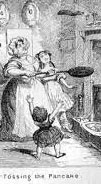On Shrove Tuesday, it was a tradition for many Christians to use the last of the fat before Lent. In England it became Pancake Day and in some places the pancakes were tossed (1837 sketch). Germanic areas in Europe and the US made doughnuts, fachnachts, or kinklings - the last only in Frederick MD.
And for Washington's Birthday ... when Washington Pies were cakes. Three cakes named after our first president were: a cake with raisins & currants (1830 recipe), Pearl ash with brandy & spices (1837), and a yeast pancake (1842).
WASHINGTON PIES
There were two types of Washington Pie. The first cake had jelly/jam or custard between the layers and appeared in print in 1849. It was like Eliza Leslie's Jelly Cake of 1830. Two thin cakes were baked (or one cut horizontally) with jam, marmalade, jelly, cooked apples/applesauce or cream/custard. Usually two layers, but a few recipes had more, like the Kentucky Jam Cake or Tennessee Stack Cake (with cooked apples). A cream or custard filled Washington Pie cake started to appear in the 1870s. More in past post HERE
The second version of Washington Pie, like bread pudding, had pieces of cake between two crusts and baked in 2 1/2 feet square pans and served in squares. The cakes were sold in Washington DC bakeries, and later moved to other cities and "consumed in great quantities at the Astor House" in New York City. More in past post HERE
WASHINGTON CAKES
For more information about the three Washington Cakes and recipes go to past post HERE.
PANCAKE DAY
George Cruikshank’s "Tossing the Pancake" in Comic Almanac of 1837.
For more and the competition at Westminster, once popular at Eton, see past post HERE
KINKLINGS, FASTNACHTS, DONUTS
These fasnachts (many spelling variants) were made with yeast, flattened with a Pa. German rolling pin, cut and fried in lard.
More info and recipe for "Fast Nacht Kuchen" (Doughnuts) from Mary at the Farm... among the Pennsylvania Germans, 1915. in past post HERE
"Kinklings" were popular in the German area of Maryland around Frederick. They are more square shaped and used to be sold as a fundraiser at churches on Fat Tuesday. For years I went to the Jefferson bakery in Jefferson which had kinklings year round. Now it's Farmer's Daughter Bakery, and they are taking orders for this year's Kinkling Day.
DOUGH NUTS. 1830 Leslie
Three pounds of sifted flour.
A pound of powdered sugar.
Three quarters of a pound of butter.
Half a large tea-cup full of best brewer's yeast.
A pint and a half of milk.
A tea-spoonful of powdered cinnamon.
A grated nutmeg.
A table-spoonful of rose-water.
Four eggs.
Cut up the butter in the flour. Add the sugar, spice, and rose-water. Beat the eggs very light, and pour them into the mixture. Add the yeast, (half a tea-cup, or two wine-glasses full,) and then stir in the milk by degrees, so as to make it a soft dough. Cover it, and set it to rise.
When quite light, cut it in diamonds with a jagging-iron, or a sharp knife, and fry them in lard. Grate loaf-sugar over them when done.
Eliza Leslie. Seventy-five Receipts for Pastry, Cakes, and Sweetmeats. Boston: 1830
TAPED TALKS
Feb 16 Tue 8-9 Fat Tuesday with Harold & Belle’s. “LA’s authentic Louisiana Creole Cuisine for over 50 years.” Jambalaya for Mardi Gras. Ryan Legaux. Global Cuisine Cooking Lessons series. Fowler Museum at UCLA TAPE HERE
©2021 Patricia Bixler Reber
Researching Food History HOME





No comments:
Post a Comment